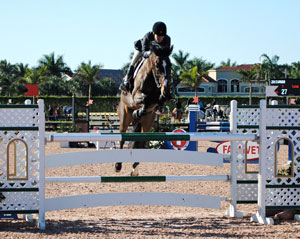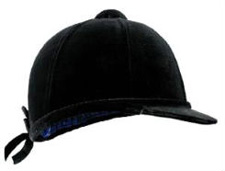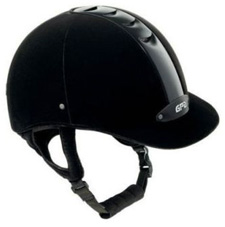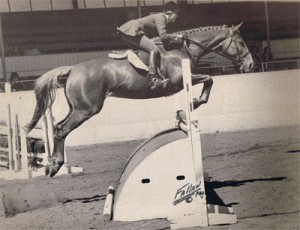Eastern and Western US Leagues Look Strong
By Erna Adelson & Jackie McFarland
After a long run beginning with the turn of this century and ending in 2009, the FEI World Cup returns to Vegas for the last time this decade. We understand the soonest it would return to the West Coast is 2015. This knowledge comes from the remarkable John Quirk, who will be featured in our World Cup Wrap-Up Issue online. He generously allowed us an interview even under an impending deadline to complete the 2009 Rolex FEI World Cup Finals Program.
Appropriately, the riders assembled to compete from the West Coast League are arguably the most exciting group to represent the western United States since the World Cup originated 20 years ago. Richard Spooner, Mandy Porter, Rich Fellers and Harley Brown of Australia represent the veterans, each with upwards of 20 years experience though they are all known to be quite gutsy, while Ashlee Bond, though not exactly new to show jumping, will turn just 24 during the competition.
We should mention that the East Coast League includes some solid riders. On top of the point rankings sits the young Kent Farrington, all of 28, who tied for eighth in Sweden last year on Up Chiqui. Olympians McLain Ward and Beezie Madden are on the list; Ward and Sapphire is as superb a match as Beerbaum and Shutterfly. Madden has a greener mount, Danny Boy, which could prove challenging. Add Todd Minikus, Lauren Hough and Christine McCrea, none of whom are new to international competition. Darragh Kerins earned enough points to represent Ireland. Rounding off the youngsters are Hillary Dobbs and Michelle Spadone, also in their 20’s, maybe not contenders to win but strong up and coming show jumpers.
2009’s USA West Coast League is without a doubt unconventional. Rich Fellers and Flexible, the wild card entry, are making the trip due to the sportsmanlike generosity of both Will Simpson and Jill Humphrey, the next riders in line based on points, who turned down the spot to allow the 2008 Rolex FEI World Cup Reserve Champion team to compete. Mandy Porter will pilot San Diego, an unexpected standout on the World Cup qualifying tour on a horse she was just “keeping fit” for Young Rider owner Danielle Korsh. Harley Brown on Cassiato, nominally representing Australia, considers himself a more appropriate representative of the California Republic. The pair will be schooled by the well-known Judy Martin, since the Australian Chef D’Equipe, is unable to attend the event.
A promising rider as a teen, Ashlee Bond took a hiatus from riding but is now storming the scene on Cadett 7. That Richard Spooner could compete on Cristallo or Ace is not surprising—the West Coast’s ubiquitous pinup has been to the World Cup Final ten times before, finishing fourth in 1998. Even in Vegas, those odds say he’s due… Note for all you new media mavens, follow all of the updates from the World Cup at: www.twitter.com/equestrisol!
West Coast World Cup Rider Interviews
A World Cup course asks many questions: Technical skill, rideability, scope, and athleticism of horse and rider are challenged by sharp turns, tricky distances, and tall obstacles. In our World Cup Wrap Up Issue we will meet with course designer Anthony “The Architect” D’Ambrosio, who will be ably assisted by Leopoldo Palacios, to discuss not only who will come up with the ultimate answers to the issues on each course, but how they tested these top international riders.
For this World Cup Preview Issue we took a closer look at the West Coast exhibitors in hopes of uncovering what else makes up the stuff of a show jumping luminary. Richard Spooner, Rich Fellers, Mandy Porter, Ashlee Bond, and Harley Brown spoke candidly about their preparations for this particular final, the challenges they have overcome previously as riders and as athletes in order to take the stage in Las Vegas, the trainers and the horses that have assisted and inspired them along the way, what they would do if they didn’t spend so much time in the tack, and even about the soundtrack that accompanies the ride.
Veterans and rookies alike were both candid and grounded in their replies.
When the World Cup week is just 7 days out… what’s your plan?
Richard Spooner: Keep the horses fit and don’t overdo. We’ll jump two-three times during the week up to the final. I try not to change routine for championships and big classes – I have a lot less chance of messing things up that way!
Ashlee Bond: We didn’t have to show at the last qualifier, so Cadett essentially took that week off, just did the treadmill for an hour. Back to work Monday of this week, Dad will get him back into fighting shape on the flat, then he’ll jump Tuesday and do the indoor exhibition class at Blenheim on Friday. After we arrive in Vegas on Monday, we just relax.
Mandy Porter: Keep the horse fit, fresh, and happy. He’ll be on a regular work schedule, not too much jumping before he goes, some trail rides working up and down hills, flatwork. Though I’m not riding in the exhibition class the Friday before we leave, I’d like to thank Blenheim for thinking of us.
Harley Brown: Trail rides going up and down hills. He may jump twice – gymnastics, some bigger jumps in the second session that’s it.
Rich Fellers: Flexible finished up in Thermal really jumping well, which was his last show. He had a light week last week – eurociser, light hacks. Now this week some good, hard flatwork and he’ll be ridden twice a day for extra conditioning. Two school sessions – one with smaller jumps and Friday a bigger school. Saturday he’ll get on the truck and head to Vegas.
How to contend with show life in the Vegas venue:
Spooner: In Vegas the lights are on all night, and the horses are in the flight path, so it can be very unsettling and the horses lose sleep. I try to keep them happy with massages and even some magnetic blanket therapy.
Porter: This horse takes pretty good care of himself, not a nervous type. He is happy in his stall.
Fellers: I might actually go in and find breaker boxes and turn off lights in Vegas if they’re disturbing.
Brown: This will be Cassiato’s maiden International competition, so we’ll do our best to treat is like any other horse show – just the jumps are bigger!
How you will ride the World Cup Warm-up on Wednesday morning? (Note that riders can also bring a horse to compete in the Las Vegas Grand Prix on Saturday)
Spooner: Go slow, ride deep in the corners, and let them know that it’s a good place to be. I’ll actually choose between riding Ace or Cristallo in the first round based on the one that feels the most comfortable on warm-up day.
Bond: Show Cadett as much of the ring as I can, get into the corners, maybe jump a combination or an oxer—he knows what he’s doing. Chivas Z will do the whole course to get acclimated.
Porter: I probably won’t do a whole course but there’s no real strict plan. It will be based on how he feels.
Fellers: With Kilkenny Rindo I’ll focus on adjustability and rideability, he isn’t as experienced. I won’t have to do much with Flexible, he’s a showman that loves his job, but is very excitable so I’ll try to make it fun without fatiguing him.
Brown: I will get him into the corners; give him a good look around. Use as much time as I can to get him settled in the ring. He’s an 18-hand warmblood but he’s got a thoroughbred brain – very electric and thinking all the time. If he settles early I’m in for a good show.
When were you the most technically challenged? Palacios, Leudi and more
Spooner: The most technical course I’ve ever ridden was Leopoldo’s 2nd round for the 2008 $1 Million CN International Grand Prix at Spruce Meadows. It had enormous scope tests, enormous stretch tests, incredible careful tests and it was technical – plus a tight time allowed. I was happy to be clean on Cristallo, finished up 3rd.
Bond: Good question! Leopoldo’s courses are insanely technical and high, specifically the 2008 $1 Million Grand Prix at Spruce. The World Cup qualifiers at Thermal were technical and tall, and the ’04 Olympic qualifiers were also very challenging.
Brown: The Sacramento Grand Prix last November, designed by Leopoldo was the most technical. Followed closely by the World Cup qualifier in Thermal designed by Aki Ylanne (Riihimaki, Finland)
Porter: The 2nd and 3rd rounds of the 2008 World Cup Finals in Sweden, designed by Rolf Leudi, were the biggest and most technical. I had 8 or 12 faults and I was just happy to get through it. When I walked it I thought it was huge – but didn’t allow myself to think that until after it was over when all the riders were talking about how big the course was.
Fellers: The 2nd round and 3rd rounds of the World Cup final last year owing to the size and width that Rolf Leudi presents. He is probably the top course designer in Switzerland. His stamp is BIG. A lot of what makes up a ‘techincal’ course is height & width – the ride changes a lot with those elements. Distances combined with the size and width –especially the width of some of the oxers – really complicated things. Everybody was walking 2,3,4 times over wondering how to ride it, choosing two different ways to ride the course. When 16h (that’s eight inches smaller than Cassiato!) Flexible jumped around that 2nd round without touching a fence I thought, ‘This little horse has what it takes. I’ll do everything I can to win.’
Your biggest challenge as an athlete?
Spooner: The balance of sport and life is a challenge as an athlete. Everyday I have to find balance, by setting achievable goals and staying within my ability to maintain them.
Bond: There really isn’t one specific thing so far, except for keeping myself and the horses fit and in fighting shape. Since I haven’t been at top level for very long that will probably change soon!
Porter: As an athlete, my stay in Switzerland at Gerhard Etters challenged my time management and get-the-job-done-well skills. It was also far, far away from home. It was a lot more work to achieve the goals daily than I was used to. I had six horses to care for completely, and I mucked, groomed, rode and competed on all of them. In a given day I sometimes worked with up to 12 horses, depending on how many clients came to try horses. I learned ways to balance the physical work and to keep my head mentally in the right place, not stress out. No one was there telling you what to do, you had to watch, learn and figure it out for yourself. Success or failure was completely up to the individual. I learned a ton over the five years I was there.
Fellers: Actually, my senior year high school I ran track for Yam Hill Carlson High School in Oregon. I had my wisdom teeth pulled the day before I did the high jump in the District Championships. That was so challenging (and painful!) I remember it to this day.
Brown: Producing horses on a regular basis. It’s a challenge but I get my greatest satisfaction producing one from zero to hero.
How do you maintain calm under high pressure?
Spooner: I thrive under pressure. That’s what I signed up for. Countless hours are spent riding in the doldrums. When the wind picks up that’s when I want to be a sailor.
Bond: It’s funny, I used to appear calm but on the inside the adrenalin was pumping. I noticed when I rode well internationally at Spruce that I was calmer in this high-pressure situation. I walk the courses with Richard [Spooner] and focus on the job, which usually calms everything down. I won’t be leaving his side at the World Cup.
Porter: I stay very focused on the task at hand. When I enter the ring, I rarely hear much around me, I am really centered on the job. Otherwise I would be a basket case!
Fellers: At any top level if you feel nervous, use it positively. It’s adrenaline. There is so much to execute, so I focus on the task at hand, go over the technique, and stay on track. This keeps me from getting distracted and worried.
Brown: The higher the better, otherwise I can get on the lackadaisical side. When the nerve ends are tingling and I’m concentrating hard, then outside influences can’t creep in. When the stakes are high, I perform better.
If you could add any horse to your string, which one would you choose and why?
Spooner: I am happy with the string I have right now. I would love to have Robinson back, but other than that I’m content.
Bond: Any horse in the world? There are so many… Shutterfly and Authentic seem to be my style. Jessica Kurten’s (IRL) Castle Forbes Libertina. But if I had could ride any horse in the World Cup, it would be Cadett 7. We have formed a partnership and really fit well together.
Porter: Shutterfly—it would be interesting to give him a go. I would also love to keep San Diego in the string, what a great ride.
Fellers: Richard Spooner’s Cristallo. He’s a real fighter and athletic, his personality reminds me of Flexible.
Brown: Ludger Beerbaum’s Ratina Z. She was crazy and brilliant.
If you had a day to spend with one clinician/trainer, past or present, who would it be?
Spooner: Hugo Simone, my mentor for years. He’s one of the only top professionals that thought I could be good at this. The most important thing he taught me was to know how much you’re able to drink before you can get on a horse. In all seriousness, though, you can’t learn the most important lessons from one person or one trainer.
Bond: Hugo—Richard’s mentor. Just because I’ve heard so many amazing, funny stories about him. Or Ludger Beerbaum. I can’t leave out Eric Lamaze. For me it’s just as important to watch them ride. I learn so much from that.
Porter: Wow, that’s tough. I watch and learn from almost everyone, everyday is a learning experience. In Europe I rode in a couple Nations Cups and found that Katie Prudent could make you believe in yourself in any situation. There are also so many Europeans that I admire, I watched a lot of them when I was there. Bernie Traurig is a fantastic trainer. Also, I once took a clinic from a cowboy named Tom Dorrance – it was one of the most educational clinics I ever rode in.
Fellers: John Whitaker—been to the bar but not the barn with him.
Brown: I’ve trained with a lot of people over the years, but Richard Spooner is my pinup boy, I think he’s a genius, a wonderful person and trainer. We probably wouldn’t do much riding but we’d have a fun time.
If you had to choose a career path other than equestrian, what would it be?
Spooner: I would have to work outside; I would probably be a gardener or landscape architect.
Bond: I already have one! I just started Bondies with a partner, it’s a lingerie sportswear line, a pretty version of sports bras and underpants. It’s what we were lacking in underwear. I took sports bra technology pioneered by Nike and adapted it to a much sexier level. But I can still ride, even, sleep in it. The line is debuting at the World Cup!
Porter: Sports medicine or working in therapeutic horseback riding.
Fellers: I was in school to be a contractor but the economy was so bad (similar to now) that my father advised me to think of another career, so I started a training business.
Brown: A golfer, a left-hander like Phil Nicholson. It’s easier to take golf clubs around the world than horses! Eighteen holes takes four hours – instead of 90 seconds on course where if you screw up the first fence you’re done.
What is on your playlist or what music do you listen to right before/in the midst of/directly after a competition?
Spooner: Maybe the Eagles, Sting, nothing too radical. Cristallo would like Twisted Sister, Ace would like Julio Iglesias.
Bond: Something chill like the Cold War Kids or Rebelution. For Cadett 7 it’s Lupe Fiasco’s Superstar.
Porter: I don’t listen to anything in particular, but I have a friend who calls me and leaves a song on my voicemail. Something that lightens the mood for me, like Van Halen’s JUMP. Justin Timberlake’s Sexy Back for San Diego.
Fellers: I always listen to Stranglehold by Ted Nugent before going out. It’s on my son’s iPod. Flexible would like some classic and hard rock like AC/DC.
Brown: I like Coldplay, sometimes even while riding. Cassiato would listen to Queen’s We Are The Champions.
Thank you all for your time and we look forward to cheering you on from the stands in Las Vegas!
 Beezie was attesting to the importance of helmet use while riding horses, and pointed out that if a sport such as skiing, in which helmet use was nonexistent a decade ago, can experience a universal shift to helmet wearing, there’s no reason that the horse industry can’t do the same.
Beezie was attesting to the importance of helmet use while riding horses, and pointed out that if a sport such as skiing, in which helmet use was nonexistent a decade ago, can experience a universal shift to helmet wearing, there’s no reason that the horse industry can’t do the same. Show Jumpers Should Strap One On
Show Jumpers Should Strap One On A two-time Olympic gold medalist and show jumping icon, Beezie is fully aware that thousands of horse enthusiasts look up to her and other grand prix show jumpers as role models. She believes that not wearing her helmet, even in the warm up ring at a competition, sets a bad example for the up and comers who watch her and tend to emulate her every move. “For the last four or five years, I’ve always had a helmet on, every time I’m on a horse.”
A two-time Olympic gold medalist and show jumping icon, Beezie is fully aware that thousands of horse enthusiasts look up to her and other grand prix show jumpers as role models. She believes that not wearing her helmet, even in the warm up ring at a competition, sets a bad example for the up and comers who watch her and tend to emulate her every move. “For the last four or five years, I’ve always had a helmet on, every time I’m on a horse.”


 We Bring You La Baule
We Bring You La Baule


 Imagine watching the art of good riding: jumping hunt obstacles that ask different questions of horse and rider – negotiating turns, establishing a true hunter pace, trotting a wide fence like one you might find in the country.
Imagine watching the art of good riding: jumping hunt obstacles that ask different questions of horse and rider – negotiating turns, establishing a true hunter pace, trotting a wide fence like one you might find in the country.